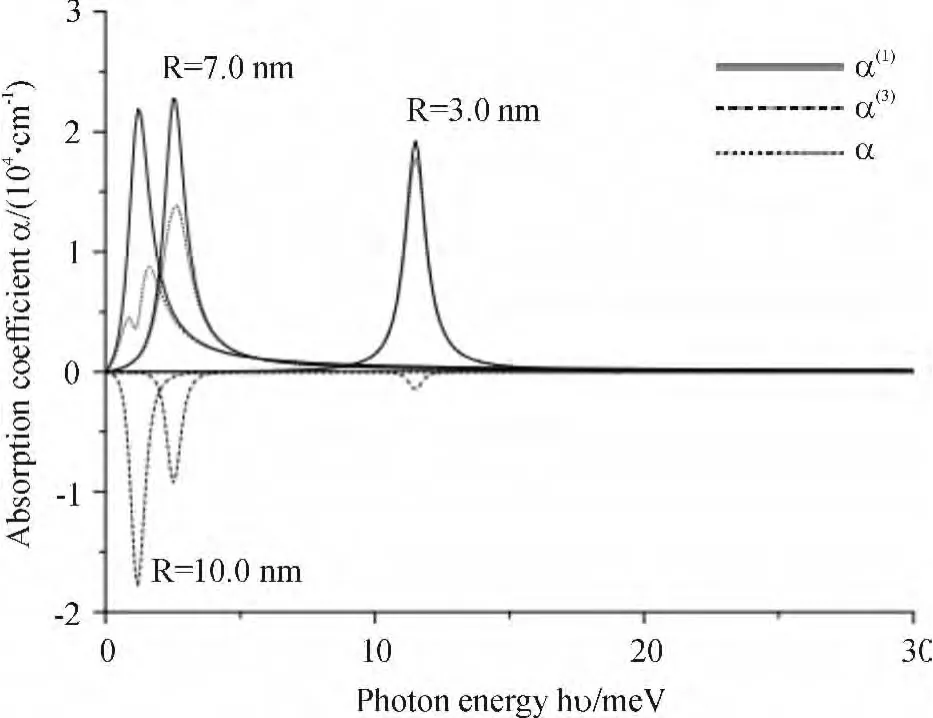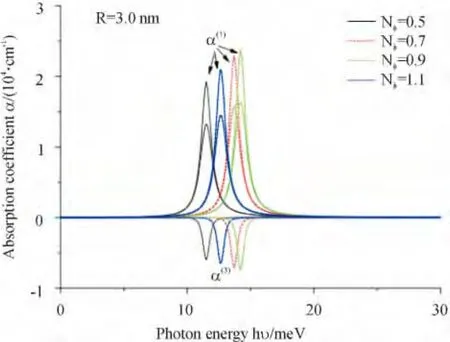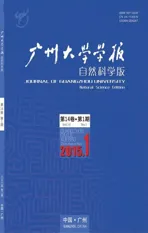半导体纳米环中激子的磁场效应
2015-12-29解文方
解文方
(广州大学物理与电子工程学院,广东广州 510006)
In nanoscale semiconductor quantum rings[nanorings(NRs)],charged carriers(electrons and holes)are confined in a small region and consequently the Coulomb interaction is enhanced.Compared with nanoscale semiconductor quantum dots,NRs belong to another kind of topological structures in which more rich phenomena can be clearly shown.These semiconductor nanodots and NRs are widely applied for fabricating single electron transistors,low threshold laser,optical memories,solar cells,light-emitting diodes,biological markers and so on.On the other hand,the application of a magnetic field leads the enhancement of the localization of both the electron and the hole in NRs.Under the influence of a magnetic field,some interesting physical phenomena of NRs,e.g.,persistent currents and Aharonov-Bohm(AB)effect,can be observed[1-2].It is now well recognized that the low-density regime is dominated by the exciton absorption/recombination.Electron-hole interaction and correlation effects are shown to play an important role in electronic structures and optical properties of excitons in NRs[3].The existence of bound states of an exciton offers a unique opportunity to explore the AB effect[4-6]for excitons in NRs[7-8].Hence,the behavior of excitons is very important to understand the optical properties of lowdimensional semiconductor systems.
The electronic and optical properties of NRs will cause the AB oscillation when a variable magnetic field is perpendicularly applied to the plane of the ring[9].Experimental observation on the AB oscillation in NRs was reported[2,10-11].In order to interpret experimental observations,some authors have theoretically studied the excitons in NRs[8,12-14].In recent years,the nonlinear optical properties of NRs have attracted an enormous interest because they have the potential for device applications in far-infrared laser amplifies,photodetectors,and high-speed electro-optical modulators[15-18].In the nonlinear optical properties of NRs,the analysis of exciton states is inevitable because the confinement of carriers in such structure leads to the enhancement of the oscillator strength of electron-hole excitations.Theoretical work started with Hanamura[19]who studied the third-order optical polarizations due to the excitons in semiconductor microcrystallinities.The results showed that optical nonlinearity is very large when one considers excitonic effects.Recently,a number of theoretical investigations of excitonic effects on the optical properties in NRs have been published[20-22].Up to now,the study of the magnetic effect on the nonlinear optical properties of an exciton in semiconductor NRs is still rare.In this paper,we will investigate the behavior of an exciton in semiconductor NRs under an external magnetic field.We assume the NR to be infinitesimally thin(one-dimensional),and use modified Coulomb interactions[23].We use exact diagonalization method to calculate the exciton oscillator strength as a function of the magnetic field.The linear,third-order nonlinear and total optical absorption coefficients(ACs)of an exciton in semiconductor NRs are calculated in order to investigate the effects of the external magnetic field and the ring radius.
1 Theory
Let us consider an electron-hole pair localized on a NR.Let a magnetic field be perpendicular to the plane of the ring.In the effective mass approximation,the Hamiltonian of an exciton is given by

wheremeandmhare the effective masses of an electron and a hole,respectively,eis the electron charge,andcis the speed of light.→reand →rhare the position vectors of the electron and the hole,respectively.Aeand Ahdenote the magnetic vector potentials of the electron and the hole,respectively,andVeh(|→re-→rh|)describes the electron-hole Coulomb interaction and|→re-→rh|is the relative distance between the electron and the hole.In what follows we assume that the ring has radiusRand infinitesimal thickness.With the symmetric gauge for vector potential→A=B(-y,x,0)/2,the Hamiltonian can then read

where θeand θhdenote the azimuthal coordinates of the electron and the hole,respectively,andNφis the number of flux quanta threading the ring.In the absence of the Coulomb interaction,the wave functions of an electron and a hole are given by

wherekeandkhare integers.The corresponding ener-
gies are

Hence,the single-particle energy with a definite angular momentum depends quadratically on the number of flux quanta.For typical NRs[10,24],the energy scale of the interlevel separation,WhenNφexceeds 0.5,the electron possesses a nonzero angular momentum in the ground state.The low energy sector as a function ofNφwill then consist of a set of cut parabolas,with smooth minima for integerNφ,and sharp maxima for half-integerNφ.
The Coulomb interaction in Eqs.(1)and(2)is modeled by the following approximation,

where ε is the effective dielectric constant,andd=D/Rwhich the parameter D is introduced to account for the effect of finite thickness of the ring[23,25].
The Hamiltonian has cylindrical symmetry which implies that the total orbital angular momentumL=ke+khis a conserved quantity,i.e.,a good quantum number.Hence,the trial wave functions for computing the energies of low-lying state exciton are taken as

The matrix diagonalization method consists in spanning the Hamiltonian for a given basis and extracting the lowest eigenvalues of the matrix generated.The calculation of matrix elements of the Coulomb interaction is realized by introducing the center of mass and relative coordinates

The important carrier confinement in low-dimensional semiconductor systems leads to an enhancement of the electron-hole Coulomb interaction.One consequence of this situation is an important increase of the oscillator strengths of excitons in a semiconductor nanostructure as compared to the bulk values.The observation of oscillator strength is imperative especially in the study of optical properties and they are related to the electronic dipole allowed absorptions.Moreover,the outcome of the results will be viewed on the fine structure of the optical absorption.After the energy levels and corresponding wave functions are obtained,the oscillator strength for the semiconductor NRs can be calculated.The oscillator strengthPfifor an optical transition between an initial state|i> and final state|f> is given by the well-known relation called Fermi rule that is defined as[26]

wheremμ=memh/(me+mh)is the reduced mass of the exciton,Mfiis the dipole position matrix element of an optical transition from|i> state to|f> state,andEfiis the energy difference between the final and initial states.Large values ofPficorrespond to a large transition matrix element.On the other hand,from the oscillator strength,we can also obtain additional information on the fine structure and selection rules of the optical absorption[27].In the dipole-allowed optical transitions of an exciton,the angular momenta must differ by unity.Hence,we restrict our study to the transition of theL=0 state to theL=1 state.
Based on the compact-density-matrix approach,the total optical AC is given[28-29]

where


and are the linear and third-order nonlinear optical ACs,respectively.σsis the electron density,μ is the permeability of the system defined as μ =1/ε0c2wherecis the speed of light in vacuum and ε0is the electrical permittivity of the vacuum,Iis the incident optical intensity,nris the refractive index and εR=n2rε0is the real part of the permittivity.Γ is the phenomenological operator.Nondiagonal matrix element Γfi(f≠i)of operator Γ,which is called as the relaxation rate offthstate andithstate,is the inverse of the relaxation timeTfifor the states|f> and|i>,namely Γfi=1/Tfi.
2 Results and discussion
All calculations were performed using the following parameters:me=0.067m0,wherem0is the free electron mass,me/mh=0.25,D=0.05R(the qualitative results are not sensitive to D),ε =13.1,σs=5.0 ×1016·cm-3,Γfi=1/1.4ps-1,andnr=3.2.The basis functionseikeθe+ikhθh/2π are used to diagonalize H,wherekeandkhare integers;each ranges from -20 to 20.This is sufficient to obtain accurate solutions.After the diagonalization,the eigenenergies E are obtained.From Eqs.(2)and(5),we found that the kinetic energy of an exciton in a NR is proportional toR-2,and the interaction term toR-1.Thus changing the ring radius changes the ratio between the kinetic and Coulomb energies and transfers the system from weakly(small radii)to strongly interacting(large radii).In order to investigate the influence of the Coulomb interaction on the optical properties of semiconductor NRs,in Figs.1,the normalized oscillator strengths of an exciton in a semiconductor NR as a function of the number of flux quanta have been plotted for three different radiiR=3.0 nm a),R=7.0 nm b),andR=10.0 nm c).It is readily seen that in the case of small radii(weak interactions)the magnetic field dependence of the oscillator strength exhibits distinct oscillations and resembles that of a single particle,i.e.,the AB oscillation of the oscillator strength as a function of the number of flux quanta.It is obvious that Figs.1b and 1c show the AB oscillation as a function of the magnetic flux within two flux periods at different values ofR.We found that as the ring radius increases,the amplitude of excitonic AB oscillations increases less for a large ring radius but the effect is still revealed.Hence,in the case of small radii(weak interactions),an increase inRleads to a reduction in the amplitude of the oscillation of the oscillator strength.However,as ring radius further increased(strong interactions),we found that the oscillator strength of largeRdepends smoothly on the number of flux quanta,i.e.,the excitonic AB oscillation would disappear from the oscillator strength.This result shows that the ring radius(i.e.,the electronhole Coulomb interaction)has an important influence on the optical properties of an exciton in semiconductor NRs.ear,total optical ACs of an exciton in a GaAs NR as a function of the incident photon energy atI=0.015 MW·cm-2andNφ=0.5.Note that variation of the ring radius,R,also implies variation of the electronhole interaction.The electron-hole interaction influence of a semiconductor NR is obvious.It is readily seen that a ring-radius-induced shift toward lower energy,red-shift,of the resonant peaks is detected in the semiconductor NR.This is because as the ring increases,the electron-hole interaction increases and an obvious decrement in the energy difference between the lower and upper states is obtained.We also note that the intensities of the third-order nonlinear optical AC increase fast so that those of the total optical AC decrease fast with increasing ring radius.The physical origin is that the transition probability will increase and the energy difference between the subbands will decrease with increasingRin NRs,therefore leading to the magnitude of the third-order nonlinear optical AC increasing considerably and to the total optical AC decreasing.It is also interesting that a saturation case is observed on the total AC for a large ring radius of the semiconductor NR.We found that the total absorption peak will be significantly split up to two peaks,which is in consequence of the absorption at linear center which will be strongly bleached whenR=10.0 nm.Therefore,if it is desired to obtain a larger nonlinear optical absorption in the semiconductor NR,then a relatively larger ring radius(a relatively stronger interaction)should be employed.

Fig.1 Dependences of the normalized oscillator strength of an exciton in the semiconductor NR on the number of flux quanta for three different values of the ring radius,a)R=10.0 nm,b)R=7.0 nm,and c)R=3.0 nm.In Fig.2 we plot the linear,third-order nonlin-

Fig.2 Linear,third-order nonlinear,and total optical ACs of an exciton in the semiconductor NR as a function of photon energy for the different R values with Nφ=0.5,and I=0.015 MW·cm-2
Finally,in order to observe further the effect of the external magnetic field on the optical absorptions,in Fig.3,we plot the linear,third-order nonlinear,and total optical ACs of an exciton in a GaAs NR as a function of the incident photon energy for the different values of the magnetic fluxes atR=3.0 nm andI=0.025 MW·cm-2.As we can see from this figure the all optical ACs are not monotonic functions of hυ.In agreement with Fig.1,it shows the AB oscillations of an exciton in the linear,third-order nonlinear and total optical ACs.It is readily seen that,at the beginning,the peak position of the optical ACs shift to higher energy(blue shift)with increasing the external magnetic field.Then the peak position of all ACs will shifts to lower energy(red shift)with increasing the external magnetic field further.On the other hand,we find that,at the beginning,the intensities of all ACs increase with increasingNφ.Then,asNφincreases further,the intensities of all ACs decrease.This result shows an excitonic AB oscillation in the optical absorptions in a semiconductor NR.This phenomenon tells us by varying the external magnetic field,it is possible to control the frequency shift and the peak intensity of the optical absorptions of an exciton in a semiconductor NR.

Fig.3 Linear,third-order nonlinear,and total optical ACs of an exciton in the semiconductor NR as a function of photon energy for the different Nφvalues with R=3.0 nm,and I=0.025 MW·cm-2
In conclusion,we have investigated the magnetic effect on the optical absorptions of an exciton in a semiconductor NR by using the matrix diagonalization method and the compact density-matrix approach within the effective-mass approximation.Based on the computed energies and wave functions,the oscillator strength,the linear and the nonlinear optical absorptions have been examined.It has been seen that the oscillator strength and the optical absorptions of an exciton in a semiconductor NR exhibit AB oscillation for small ring radius(weakly interacting).The results show that it is possible to control the frequency shift and the intensity in the absorption spectrum of the exciton by varying the external magnetic field in a semiconductor NR.
[1] MAILLY D,CHAPELIER C,BENOIT A.Experimental observation of persistent currents in GaAs-AlGaAs single loop[J].Phys Rev Lett,1993,70:2020-2022.
[2] FUHRER A,LÜSCHER S,IHN T,et al.Spin filter using a semiconductor quantum ring side-coupled to a quantum wire[J].Nature:London,2001,413:822-826.
[3] GAMMON D,SNOW E S,SHANABROOK B V,et al.Fine structure splitting in the optical spectra of single GaAs quantum dots[J].Phys Rev Lett,1996,76:3005-3008.
[4] AHARONOV Y,BOHM D.Significance of electromagnetic potentials in the quantum theory[J].Phys Rev,1959,115:485-489.
[5] BYERS N,YANG C N.Theoretical considerations concerning quantized magnetic flux in superconducting cylinders[J].Phys Rev Lett,1961,7:46-49.
[6] CHAKRABORTY T,PIETILÄNEN P.Interacting-electron states and the persistent current in a quantum ring[J].Solid Stat Commun,1993,87:809-812.
[7] CHAPLIK A.Magnetoexcitons in quantum rings and in antidots[J].JETP Lett,1995,62:900-904.
[8] RÖMER R A,RAIKH M E.Aharonov-Bohm effect for an exciton[J].Phys Rev B,2000,62:7045-7049.
[9] BÜTIKER M,IMRY Y,LANDAUER R.Josephson behavior in small normal one-dimensional rings[J].Phys Lett A,1983,96:365-367.
[10] LORKE A,LUYKEN R J,GOVOROV A O,et al.Spectroscopy of nanoscopic semiconductor rings[J].Phys Rev Lett,2000,84:2223-2226.
[11] WARBURTON R J,SCHÄFLEIN C,HAFT D,et al.Optical emission from a charge-tunable quantum ring[J].Nature,2000,405:926-929.
[12] CHAPLIK A V.Neutral and charged magnetic excitons in finite-width quantum rings[J].JETP Lett,2001,92:169-173.
[13] SONG J,ULLOA S E.Magnetic field effects on quantum ring excitons[J].Phys Rev B,2001,63:125302.
[14] HU H,ZHU J L,LI D J,et al.Aharonov-Bohm effect of excitons in nanorings[J].Phys Rev B,2001,63:195307.
[15] EOUGENIOUS L IVCHENKO.Optical spectroscopy of semiconductor nanostructures[M].Alpha Science International Ltd.2005.
[16] MANUK G B,RICARDO L R,MIGUEL E M-R,et al.Donor impurity-related linear and nonlinear intraband optical obsorption coefficients in quantum ring:Effect of Applied electric field and hydrostatic pressure[J].Nanos Res Lett,2012(7):538.
[17] XIE W F.Aharonov-bohm oscillation of photoionization cross section in a quantum ring with a repulsive scattering center[J].Phys Lett A,2013,377:903-906.
[18] MUGHNETSYAN V N,MANASELYAN A K,BARSEGHYAN M G,et al.Simultaneous effects of hydrostatic pressure and spin-orbit coupling on linear and nonlinear intraband optical absorption coefficients in a GaAs quantum ring[J].J Lumin,2013,134:24-27.
[19] HANAMURA E.Very large optical nonlinearity of semiconductor microcrystallites[J].Phys Rev B,1987,37:1273-1279.
[20] MASLOV A V,CITRIN D S.Enhancement of the Aharonov-Bohm effect of neutral excitons in semiconductor nanorings with an electric field[J].Phys Rev B,2003,67:121304.
[21] GONZÁLEZ-SANTANDER C,DOMÍNGUEZ-ADAME F,RÖMER R A.Excitonic Aharonov-Bohm effect in a two-dimensional quantum ring[J].Phys Rev B,2011,84:235103.
[22] XIE W F.Optical absorptions of an exciton in a quantum ring:Effects of the repulsive core[J].Phys Lett A,2013,377:2647-2652.
[23] BAO C G,HUANG G M,LIU Y M.Symmetry background of the fractional Aharonov-Bohm oscillation and an oscillation in dipole-transitions of narrow quantum rings with a few electrons[J].Phys Rev B,2005,72:195310.
[24] RIBEIRO E,GOVOROV A O,CARVALHO J W,et al.Aharonov-bohm signature for neutral polarized excitons in type-II quantum dot ensembles[J].Phys Rev Lett,2004,92:126402.
[25] KORKUSINSKI M,HAWRYLAK P,BAYER M.Negatively charged exciton on a quantum ring[J].Phys Status Solid B,2002,234:273-282.
[26] AYHAN Ö,YUSUF Y,BEKIR Ç,et al.Computation of the oscillator strength and absorption coefficients for the intersubband transitions of the spherical quantum dot[J].Optics Commun,2009,282:3999-4004.
[27] CHAKRABORTY T,PIETILÄINEN P.Optical signatures of spin-orbit interaction effects in a parabolic quantum dot[J].Phys Rev Lett,2005,95:136603.
[28] KARABULUT ,ŞAFAK H,TOMAK M.Excitonic effects on the nonlinear optical properties of small quantum dots[J].J Phys D:Appl Phys,2008,41:155104.
[29] KARABULUT ,BASKOUTAS S.Linear and nonlinear optical absorption coefficients and refractive index changes in spherical quantum dots:Effects of impurities,electric field,size and optical intensity[J].J Appl Phys,2008,103:73512.
